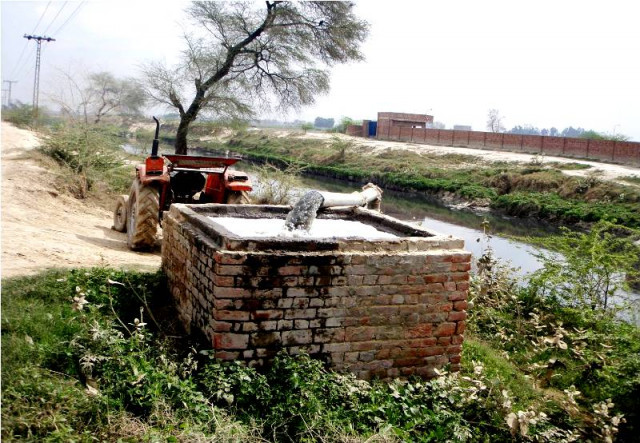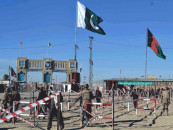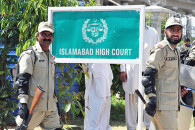Public health: Govt looks the other way on poisonous food
Farmers on city’s outskirts using water contaminated with industrial waste to grow crops.

In early August, Maqsood Qayyum planted spinach, carrots, cauliflower and raddish on 120 acres in Ladhkay Bhullar, a village about six kilometres southeast of Kahna.
The 500 or so farmers here are allowed to draw water from the BRB Canal for two weeks each month. The rest of the time they draw water from Hadiara drain. Originally a seepage and storm water drain, Hadiara now also carries the sewage of illegal housing societies and effluents from hundreds of small industrial units.
“We shift to pumping sewage water every other week. Water is available in the canal for one week and then there is no water for a week,” says Qayyum.
Soon, the vegetables he planted in August will be ready for harvesting. Most of them will end up at the fruit and vegetable markets in Kahna and Badami Bagh.
Ladhkay Bhullar is one of 13 large villages on the outskirts of Lahore that draw water contaminated with organic and industrial pollutants, including heavy metals, from the Hadiara drain to grow crops which are later supplied to the city, according to the Environmental Protection Department. These heavy metals build up in the body’s organs and cause cancer and other diseases.
Qayyum, for his part, worries that the use of sewage water will result in a hardening of the soil and lower yields, though not about the dangers of the crops. “We are worried about the village’s future. This land brings food to our dinner tables,” he says.
Though the government is aware of the problem identified by the EPD, no department is taking the responsibility to do anything about it. Meanwhile, Lahore’s fruit and vegetable markets are selling carcinogenic food to an unsuspecting population.
Qayyum says that a group of 30 village elders had approached the Irrigation Department office in Dharampura to demand that they be allowed more water from the BRB Canal, but they were made no promises.
The Sattukatla drain joins Hadiara on Raiwind Road and Charrar drain about 22 kilometres from Kasur on Ferozepur Road. About 60 dyeing units dump untreated waste into Charrar and 300 into Sattukatla before they join Hadiara, which is itself contaminated by 100 textile units and three tanneries.
The farmers in Bhallar village, about three kilometres from Kahna, have not been able to use canal water in five years. They rely solely on water from the Hadiara drain to grow crops.
Sabir Bhatti, a Bhallar resident, grows rice and sugarcane on 22 acres. He says that the yield per acre is 1,200 kg when drain water is used, compared to only 800kg when canal water is used. But the quality of rice he grows has deteriorated. “Seven to eight hours after cooking, the rice changes from white to greyish black,” he says.
Farman Ali of Thatta village says farmers here are allowed to pump water from the canal for 15 minutes a day per acre. The rest of the time, they use drain water, for which they use diesel-powered pumps.
Problem identified
A 2009 study done at the Institute of Soil and Environmental Sciences, University of Agriculture, Faisalabad, found that there were elevated levels of heavy metals in Hadiara drain water as well as in vegetables grown on land irrigated with drain water. The levels of heavy metals found exceeded safe consumption levels
“The vegetables grown using this polluted water have much higher concentrations of heavy metals than the safe standard limits (up to the time, no standards for safe limits of metals in vegetables had been established in Pakistan so Indian standards were used for safe limits),” says the study.
Yasir Gul, an EPD inspector who recently did a survey of the various types of industrial discharge into the drains in Lahore, says that 13 big villages, each with a population between 5,000 and 25,000, draw drain water for agriculture.
He said 60 units, mostly textile and dyeing, dispose of waste in the Charrar, and 300 units of the Quaid-i-Azam Industrial Estate dump their waste in the Satukatla. Three tanneries near Kahna dump untreated waste directly into the Hadiara drain, he said.
According to Gul’s report, Hadiara is joined by 13 drains. Laboratory results show its gray water to exceed the permissible biochemical oxygen demand (BOD) and chemical oxygen demand (COD) limits set in Pakistan, rendering it unsuitable for agriculture use.
Under the national environment quality standards, BOD and COD should not exceed 80mg/litres and 150mg/litres, respectively. In Hadiara drain, BOD ranges from 120 to 130 mg/litres and COD from 300 to 450 mg/litres. Some 115 pumps draw sewage for crop cultivation along the 55-kilometre drain after entering Pakistan.
Govt (in)action
The EPD has issued 254 environment protection orders to factories in the Quaid-i-Azam Industrial Estate and 54 textile units clustered around the Charrar drain over the last five months, but this has had little effect. The cases have been forwarded to the Punjab environmental tribunal, a body which had been defunct between July 2011 and June 2012, during which time over a thousand pending cases piled up.
Meanwhile, the secretaries of for irrigation and power, food, and public health and engineering, said there was nothing they could do to stop the use of sewage water contaminated with heavy metals for growing crops.
Khalid Masood Chaudhry, the secretary of the Irrigation and Power Department, said that the department carried out annual inspections of storm drains prior to the monsoons to check and remove obstructions. “The department’s job is to ensure no infrastructure damage is caused to the drains; we are not responsible for farmers using the water,” he said. He said that the use of sewage water for crops was illegal. “But we are not tasked with keeping a check on the use of effluent.”
Irfan Ali, the Food Department secretary, said although checking the quality of crops is his department’s responsibility, inspecting use of sewage to raise those crops isn’t. The EPD should look into this, he said.
Read: Heavy metals: Poison in our food
Published in The Express Tribune, October 6th, 2012.



















COMMENTS
Comments are moderated and generally will be posted if they are on-topic and not abusive.
For more information, please see our Comments FAQ